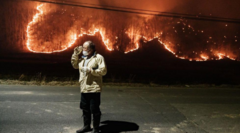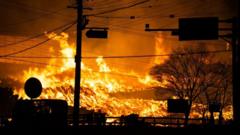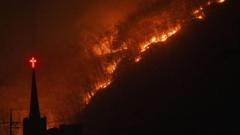The largest wildfires in South Korea's history have wreaked havoc in the southeast region, consuming over 35,810 hectares and leading to 27 confirmed deaths along with thousands of evacuations. Experts attribute the unprecedented disaster to an alarming mix of strong winds, dry land, and vast pine forests. Human activities are believed to have ignited the flames, but the rapid spread of fire is largely due to the environmental conditions present, including a high concentration of pine trees which contain resin – a substance that accelerates fire intensity and longevity. As stated by Lee Byung-doo from the National Institute of Forest Science, these forests become particularly dangerous during wildfires, intensifying the flames and leading to the brutal condition currently faced.
**South Korea Faces Unprecedented Wildfires: An Analysis of Causes and Consequences**

**South Korea Faces Unprecedented Wildfires: An Analysis of Causes and Consequences**
The recent wildfires in South Korea mark a devastating environmental crisis, fueled by various climatic and geographical factors.
Climate change exacerbates this situation, pushing temperatures well above the seasonal norms. The heat and prolonged dry spells have laid the groundwork for the wildfires, giving them the opportunity to spread rapidly across the landscape. The harsh reality of the climate crisis has been underscored by South Korea's disaster chief, revealing that rising temperatures could be significantly linked to global warming.
Another noteworthy factor influencing the high death toll is the age demographic of the impacted region. North Gyeongsang province is one of South Korea's oldest areas, leading to difficulties in evacuation for many older residents who may be frail or less mobile. This vulnerability was dramatically highlighted by reports of unnecessary losses during evacuations, with caretakers struggling to safely relocate the elderly.
Beyond the loss of life, the wildfires have also inflicted significant damage to the cultural heritage of the region, with historical temples and relics being lost in the inferno. As recovery efforts begin, officials emphasize the need for comprehensive strategies to support the wellbeing of the elderly population and to mitigate future fire risks through improved forestry management and climate action.
While the immediate focus is now on damage assessment and supporting affected communities, the broader implications of this environmental disaster highlight an urgent need to address underlying factors contributing to such cataclysmic events.
Another noteworthy factor influencing the high death toll is the age demographic of the impacted region. North Gyeongsang province is one of South Korea's oldest areas, leading to difficulties in evacuation for many older residents who may be frail or less mobile. This vulnerability was dramatically highlighted by reports of unnecessary losses during evacuations, with caretakers struggling to safely relocate the elderly.
Beyond the loss of life, the wildfires have also inflicted significant damage to the cultural heritage of the region, with historical temples and relics being lost in the inferno. As recovery efforts begin, officials emphasize the need for comprehensive strategies to support the wellbeing of the elderly population and to mitigate future fire risks through improved forestry management and climate action.
While the immediate focus is now on damage assessment and supporting affected communities, the broader implications of this environmental disaster highlight an urgent need to address underlying factors contributing to such cataclysmic events.






















